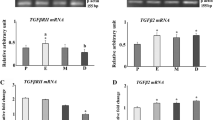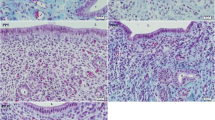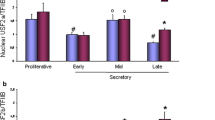Abstract
The conformation of estrogen receptor (ER) and its in vitro transformation by RNase, Urea and ATP were analysed using the uteri of young (16 weeks) and old (92 weeks) rats. Following the digestion of ER with proteolytic enzymes like trypsin and chymotrypsin and the analysis of cleaved fragments by SDS-PAGE, similar pattern is observed in both ages. In vitro transformation of ER by RNase, Urea and ATP shows that the degree of transformation is lower in old than young. Furthermore, the transformed ER from old is less capable of binding to DNA than that from young. Thus our results show that the conformation of ER probably does not change with age, but the degree of transformation and the ability of transformed receptor to bind to DNA decrease with age.
Similar content being viewed by others
References
O'Malley BW, Means AR: Female steroid hormones and target cell nuclei. Science 161: 610–620, 1968
Yamamoto KR: Steroid receptor regulated transcription of specific genes and gene networks. Ann Rev Genet 19: 209–252, 1985
Beato M: Gene regulation by steroid hormone. Cell 56: 335–344, 1989
Moudgil VK, Eessalu TE, Buchou T, Renoir J-M, Mester J, Baulieu EE: Transformation of chicken oviduct progesterone receptor in in vitro. Effect of hormone, salt, heat and ATP. Endocrinology 116: 1267–1274, 1985
Baulieu EE: Steroid hormone antagonists at the receptor level: a role for the heat-shock protein MW 90,000 (hsp 90). J Cell Biochem 35: 161–164, 1987
Milgrom E, Atger M, Baulieu EE: Acidophilic activation of steroid hormone receptors. Biochemistry 12: 9158–9205, 1973
Higgins SJ, Rousseau JA, Baxter JD: Nature of nuclear acceptor sites for glucocorticoid and estrogen receptor complexes. J Biol Chem 248: 5873–5879, 1973
Schauer M, Chalepakis G, Willman T, Beato M: Binding of hormone accelerates the kinetics of glucocorticoid and progesterone receptor binding to DNA. Proc Natl Acad Sci USA 86: 1123–1127, 1989
Chuknyiska RS, Justiniano C, Roth GS: Impaired conversion of rat uterine estradiol receptors during aging. Exp Gerontology 21: 256–265, 1986
Thomos T, Kiang DT: A twenty-two fold increase in the relative affinity of estrogen receptor to poly (dA-dC). Poly (dG-dT) in the presence of polyamines. Nucleic Acids Res 16: 4705–4720, 1988
Moudgil VK, Vandenheade L, Hurd C, Eliezer N, Lombardo G: In vitro modulation of rat liver glucocorticoid receptor by urea. J Biol Chem 262: 5180–5187, 1987
Moudgil VK, Eessalu TE: Activation of estradiol receptor complex by ATP in vitro. FEBS Letts 122: 189–192, 1980
Yang CR, Mester J, Wolfson A, Renoir J-M, Baulieu EE: Activation of the chick oviduct progesterone receptor by heparin in the presence or absence of hormone. Biochem J 208: 399–406, 1982
Roth GS: Hormone action during aging. Mech Ageing Dev 9: 497–514, 1979
Thakur MK: Molecular mechanism of steroid hormone action during aging — a review. Mech Ageing Dev 45: 93–110, 1988
Katzenellenbogen BS, Elliston JF, Monsma FJ, Springer PA, Ziegler YS: Structural analysis of covalently labeled estrogen receptors by limited proteolysis and monoclonal antibody reactivity. Biochemistry 26: 2364–2373, 1987
Laemmli UK: Cleavage of structural proteins during the assembly of the head of bacteriophage T4. Nature 227: 680–685, 1970
Alberts B, Herrick G: DNA-cellulose chromatography. In: L Grossman, K Holdave (eds) Methods in Enzymol., vol 21, Academic Press, pp 198–217, 1971
Horigome T, Golding TS, Quarmby VE, Lubahn DB, McCarty Sr K, Korach KS: Purification and characterization of mouse uterine estrogen receptor under conditions of varying hormonal status. Endocrinology 12: 2099–2111, 1987
Horigome T, Ogata F, Golding TS, Korach KS: Estradiol stimulated proteolytic cleavage of the estrogen receptor in mouse uteri. Endocrinology 123: 2540–2548, 1988
Kumar V, Green S, Stack G, Berry M, Jin J-R, Chambon P: Functional domains of the human estrogen receptor. Cell 51: 941–951, 1987
Elliston JF, Katzenellenbogen BS: Comparative analysis of estrogen receptors covalently labeled with an estrogen and an anti-estrogen in several estrogen target cells as studied by limited proteolysis. J Steroid Biochem 29: 559–569, 1988
Erdos T: Properties of uterine estradiol receptor. Biochem Biophys Res Commun 32: 338–343, 1988
Notides AC, Neilson S: The molecular mechanism of the in vitro 4 S to 5 S transformation of the uterine estrogen receptor. J Biol Chem 249: 1866–1873, 1974
Saiduddin S, Zassenhaus HP: Estrous cycle, decidual cell response and uterine estrogen and progesterone receptor in Fischer 344 virgin aging rats. Proc Soc Exp Biol Med 161: 119–122, 1979
Jensen EV, DeSombre ER: Mechanism of action of female sex hormone. Ann Rev Biochem 41: 203–230, 1972
Pratt WB: Interaction of hsp 90 with steroid receptors organizing some diverse observations and presenting the newest concepts. Molec Cell Endocrinol 74: C69-C76, 1990
Hansen JC, Gorski J: Conformational and electrostatic properties of unoccupied and liganded estrogen receptors determined by aqueous two-phase partitioning. J Biol Chem 261: 13990–13996, 1985
Mendel DB, Bodwell JE, Gametchu B, Harrison RW, Munck A: Molybdate-stabilized nonactivated glucocorticoid receptor complexes contain a 90 KDa non-steroid binding phosphoprotein that is lost on activation. J Biol Chem 261: 3758–3763, 1986
Author information
Authors and Affiliations
Rights and permissions
About this article
Cite this article
Thakur, M.K., Kaur, J. Analysis in vitro of uterine estrogen receptor conformation of young and old rats. Mol Cell Biochem 105, 171–177 (1991). https://doi.org/10.1007/BF00227756
Received:
Accepted:
Issue Date:
DOI: https://doi.org/10.1007/BF00227756




